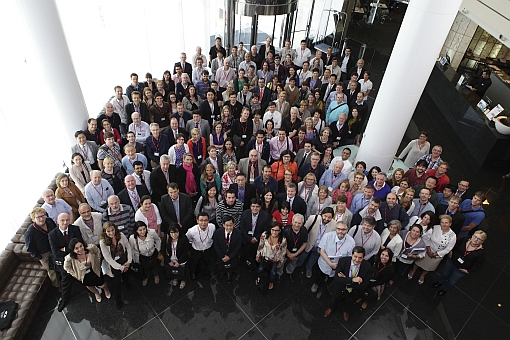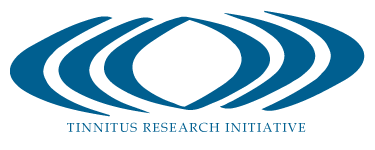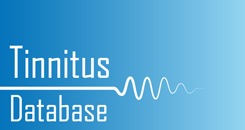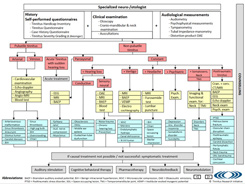Tinnitus: A Treatable Disease
May 15 - 18, 2013, Valencia (Spain)
The fascinating city of Valencia with its long historic tradition fused with its futuristic physiognomy, represented a unique venue for this year's TRI meeting.

Santiago Calatrava´s City of Art and Science (photo by Bela Benedek / www.belabenedek.com)
Inspired by Santiago Calatrava´s architecture, the meeting started with a dream: The dream to cure tinnitus. And the dream-state itself is proof of principle that this is achievable. The vast majority of tinnitus patients have no tinnitus, when they dream. Thus, identifying the neuronal difference between dream states and wakefulness may provide a hint in the search for efficient targets to cure tinnitus.
Following a clear goal, this year's meeting was clinically oriented, starting with a session in which the need for multidisciplinary work was stressed. Collaboration of Audiologists, Otologists, Neurootologists, Neurologists, Neurosurgeons, Psychiatrists and Psychotherapists is required for efficient diagnostic and therapeutic management. Further plenary talks focused on psychotherapy and sound therapy. Whereas these treatments can be extremely useful in some patients, we also have to acknowledge their limitations.
In order to overcome these limitations a deeper understanding of the involved mechanisms is needed and can be provided by basic science. Important progress has been made in demonstrating the complexity of dynamic changes of brain structure and function after hearing loss. Most important, is the differentiation between changes related to hearing loss and those related to the phantom perception. As an example, cortical tonotopic map changes, which have been considered as correlates of tinnitus in the past may be more dynamic than expected and rather reflect complex adaptive processes. Other concepts like spike timing dependent plasticity are increasingly recognized as relevant for tinnitus and its treatment.
In addition to basic science other approaches may prove beneficial to overcome current limitations. Analogous to evolutionary concepts underlying adaptation to new challenges, variability may be such an approach. TRI wants to stay a platform for the developing and testing of new ideas, being well aware that the vast majority of them might fail. By keep on trying and learning from failures, we will make progress, analogous to what evolution does in nature. As Kuhn stated in his seminal book “The structure of Scientific Revolutions”, also in science the fittest idea, the fittest concept, the fittest treatment will survive. Progress is based on failure. This is true in clinically oriented research as well. The use of neuroimaging techniques will help to better understand the neuronal effect of new interventions. In addition, the basic scientific approach will benefit from variability and creativity. As an example, large scale analysis of drug-target and side effect databases enables the identification of neuronal targets involved in the development of tinnitus as a side effect of drug treatment. Inversing this approach may provide guidance for identification of potential targets for treatment.
As important as the creativity and the open mindedness, is the application of proper methodology and research structure in order not to reject an efficient approach because of false negative results and not to follow the wrong path fooled by false positive results. The relevance of epidemiological studies has been made clear, identifying the need for activities to prevent tinnitus and hearing loss, but also to demonstrate how emotional factors and tinnitus interact. There is good evidence for example that depression is not only a potential consequence of tinnitus, but also represents a risk factor for its development.
Various research sessions discussed progress in animal research, the interaction between the auditory system and the non-auditory system in tinnitus. In addition to changes in neuronal activity, synchronicity and connectivity, alterations in neuronal variability may be relevant under pathological conditions. Neuroimaging becomes more and more successful in order to disentangle neuronal effects related to the various aspects and comorbidities of tinnitus. This knowledge can be directly implemented in brain stimulation approaches for modulating tinnitus-related brain activity. Similarly, advances in animal models offer increasing possibilities to develop and test new treatment approaches, being these pharmacological or specific stimulation approaches.

Participants of the 7th International TRI Tinnitus Conference
Whether clinicians or researchers, let’s follow our dream to find a cure for tinnitus. Let’s use the momentum built up in Valencia to foster our inspiration and motivation and to drive our research so it is worthwhile to meet again next year with new data, new information, new treatment proposals, that go “beyond the horizon”.
We therefore kindly invite all of you to come to the 8th TRI meeting in Auckland in March 10-13, 2014.
TRI 2013 - Abstract Book
Article in Tinnitus Today, the magazine of the American Tinnitus Association, Vol. 38, Number 2 Summer 2013



